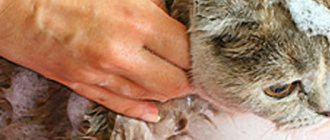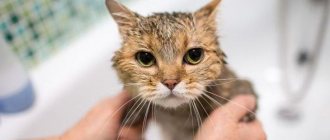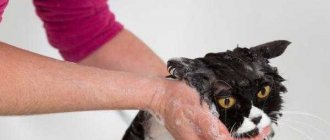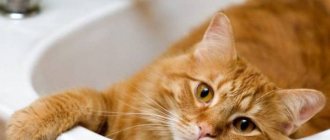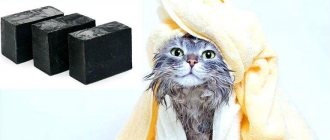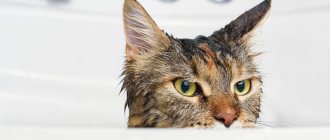Cats usually hate bathing because they don't like water, they get wet, they smell soap, they don't like being dried off, they don't understand why it needs to be done. Additionally, indoor cats don't need to be bathed at all to keep them clean because they have their own cleaning methods.
So, when should you bathe your cat? This will only be necessary if they are contaminated with dirt or any other debris. This requires using the right products, but it raises many questions such as can I bathe my cat with human shampoo? Pay attention and find out the answer and many more interesting details.
Is it safe to use human shampoo on cats?
As is the case with other animals, including us, the skin has an outer thin layer of fat, or oil layer, that serves as protection for the dermis. This layer insulates the skin from harmful external factors such as sun and cold, not completely, but enough to prevent any serious damage.
Therefore, it is not advisable to wash their fur very often, since this thin protective layer is removed, especially when using soap. Also, in our case, after years of doing this, our body gets used to using these products, but in the case of animals like cats, their body never uses them. If we exceed the frequency of bathing a cat and use strong products, we will damage its skin without you even noticing it, which can lead to problems such as dermatitis and allergies in this layer of the body.
© shutterstock
So, if you're asking yourself, "Can I bathe my cat with regular shampoo?" The answer is NO, you cannot bathe them with regular shampoo because it is not tailored to the animal's skin type.
Humans and cats have different skin pH, so our soap is too strong for cats' dermis and can therefore damage it. So what should you do if you bathed your cat with human shampoo? If you wash your cat with soap, after washing you will notice that the cat's skin is irritated, it is very itchy and uncomfortable, and with frequent use the cat's hair will begin to fall out more and more.
Which cat shampoo to choose
There are no less shampoos for cats than for humans. Each of them serves specific purposes. Detergent compositions are divided into several categories:
- For daily use. These are herbal based products. Do not cause irritation. They are needed only to wash away dirt and get rid of the smell.
- Exhibition. These are products with dyes to enhance the brightness of the color. Needs to add beauty and shine to pets participating in the competition.
- To reduce shedding. Used in the off-season. Sometimes hair falls out so intensely that additional products are used to slow down this process.
- Medical shampoos. Used as directed by a veterinarian. They help relieve irritation and disinfect the skin.
In addition, many products have been developed that take into account the characteristics of various breeds. You can choose shampoo for both the Sphynx and the Persian.
If the cat refuses to bathe or the dirt is minor, then you can use dry shampoo and apply it only to the dirty area. The product is a powder that is applied to the coat and combed out thoroughly.
Bathing is stressful for the cat, and if he actively resists the process, then for the owner. Therefore, preparation for the process is required. It is advisable not to feed your pet a couple of hours before the procedure. Long nails are trimmed and the fur is combed. The bathroom is set in advance. The water in it should be warm and not reach the cat’s ears. After washing, the wool is dried as much as possible with a towel.
Can baby shampoo be used on cats?
Some people believe that if pH-neutral soap or baby shampoo is less harsh on our skin and hair, then it may be good for animals too. The truth is that this is not true , although for us it is neutral and mild, for cats and other animals it is not. We have to think that our neutral pH is not the same as cats', and that our even baby shampoo is strong for them, so it will still damage their skin. Therefore, it is not recommended to use these shampoos to wash our feline companion.
How to wash your cat: regular shampoo, soap or special care product
Curious kittens often find themselves in situations where they urgently need to be washed.
Often, the owner’s arsenal lacks the necessary supplies to maintain hygiene. If a careless dirty fellow has soiled the whole house, you need to know how to wash the cat if there is no special shampoo. Under natural conditions, they maintain cleanliness on their own by licking their fur. If the kitten is very dirty, first wipe it with a damp cloth. Wipes soaked in lotion are not suitable for this. Only as a last resort use household chemicals. A clean pet must be wrapped up to prevent it from catching a cold.
Can dog shampoo be used on cats?
The question of whether dog shampoo can be used for cats is not a very common one as many people think that animals that are considered pets and have different similarities can use the same products without any problem. Again, this is not correct and if we wash our cat with dog shampoo, we may damage the skin and hair.
Additionally, it is important to know that anti-flea or anti-parasite shampoos for dogs are even more dangerous to cats than regular dog shampoos. This is because the anti-parasitic product included in the shampoo is not suitable, especially in concentrated quantities, so even if we only use a small drop, it can be toxic to them.
Veterinarians' opinion
As mentioned earlier, skin acidity is the most important indicator of its protection. The integrity of the skin depends on this parameter. Acidity levels between cats and humans differ significantly, which is why veterinarians do not recommend using human shampoos for bathing pets.
Experts assure that neglecting the use of special cosmetics can have a detrimental effect on the cat’s health. If you continue to use human shampoos when bathing your pet, this may lead to irreversible consequences in the future.
How to bathe a cat
Now that you know about cat shampoos, you may be wondering how to properly bathe your cat at home. It should be borne in mind that the main direction is to use shampoo for cats, which can be bought at any pet store or veterinary centers. Additionally, you can choose between a regular cat shampoo, depending on your hair type and age, or use a dry cat shampoo, ideal for those cats that are intolerant of water.
It is vital that we do not force the animal, but gradually accustom him or her to this situation, and above all, we try to do this since the cat is still a kitten. It is recommended to use a basin to reduce the volume and amount of water. The shampoo is recommended for cats and that the water be warm and never exceed 25 ºC. To dry your cat, you will need towels, and if the fur is long, use a hair dryer at a distance and with warm air until the animal is scared.
Cats are very clean and groom themselves constantly, so bathing them is not necessary unless they are very dirty. Bathe your cat once a month maximum unless absolutely necessary.
© shutterstock
If there is no suitable shampoo
If you still need to wash your pet, and there is nothing other than human shampoo, then occasionally you can still use it. In this case, you can wash the cat with baby shampoo or use an adult product, but consider the following factors:
- the smell should not be pungent;
- the product must be washed off thoroughly;
- choose shampoo with the least amount of surfactants.
Important! The shampoo is not applied directly to the animal's fur. Before washing, you need to prepare a solution and follow several rules.
Before bathing your cat with regular shampoo, you need to dilute it. 1 tablespoon per liter of water is enough. You can add a little hair conditioner to prevent your cat's thick and fine fur from becoming matted or tangled. Wash off the solution at least three times. It is necessary to completely remove all chemical particles from your pet’s fur, because the cat will begin to lick itself after water treatments.
If the cat is domestic and only walks within the apartment, then it is worth limiting its bathing to once every 3-4 months. After washing, the wool should be thoroughly dried with a dry towel.
You don't always need to wash your cat with shampoo. Sometimes you can simply wipe your pet's fur with a towel soaked in water. Sometimes this is quite enough.
Homemade shampoo for cats
It is best to make homemade oatmeal cat shampoo instead of human shampoo because this oatmeal is ideal for skin and hair care and is very gentle, ideal for skin that is allergic and prone to irritation or when the cat suffers from dermatitis.
Thus, this is a hypoallergenic shampoo that is ideal for small kittens, so it is recommended to use it for cats of any other age, except for those who need to use medicated shampoos prescribed by a veterinarian. To make this cat shampoo, follow these directions:
Ingredients
- 2 cups oatmeal in cereal or flour
- 1/4 cup baking soda
- 1 liter of mineral or distilled water
Preparation
- Grind the oats to a powder or use flour.
- Boil mineral or distilled water and, while still slightly warm, add it to the bowl until well mixed with the oats.
- Add baking soda and continue stirring until smooth. You can use a blender to speed up the process.
- Add water if it's too thick or oatmeal if you notice it's too thin.
- Let it cool down and when it reaches room temperature, you can already store the mixture in your chosen shampoo container.
- Always shake well before use.
How to properly bathe a kitten
In order to gently bathe a small kitten, you should use a specialized shampoo, using baby product only as a last resort.
When bathing your baby, you need to be especially careful not to overcool the kitten, not to pour water into his ears and rub him thoroughly after washing, not to scare him or cause stress.
In the case of using specialized medicated shampoos, they are used strictly as prescribed by the veterinarian and in this case the pet is bathed according to the proposed scheme. As a rule, in this case we are talking about antiallergic drugs, since compositions for removing external parasites up to six months of life are not prescribed due to the high toxic effect of the drugs they contain on the body.
If the kitten is a show class and is planned to be presented at exhibitions and competitions in the future, then it is better to accustom the baby to bathing from an early age. Of course, you shouldn’t do this in the first or even the second month of life, but in three or four months the first procedure can be carried out.
If the kitten has recently moved to a new home, then washing should be delayed for at least two to three weeks to give it time to adapt.
It is also important to postpone bathing for at least a month after vaccinations.
It is important to carefully comb your pet before washing, since if the tangled hairs get wet, tangles are highly likely to form, which can only be removed by cutting.
If your baby begins to get stressed while combing his hair, then you should not immediately take him to the bathroom; it is advisable to give him time to calm down and tune in to a positive mood.
In addition, you can give him treats and play. Under no circumstances should you bathe a kitten immediately after a heavy feeding. You must wait at least two to three hours.
Warm water is filled into a container—a bathtub or basin—preferably at the animal’s body temperature, about 38 °C. To prevent the paws from sliding on the surface of the container, it is advisable to place a towel on the bottom. You can throw toys into the water, this will distract the kitten’s attention during the procedure. By the way, the whole thing should be done in 15 minutes. In this case, it is advisable to prepare the water for rinsing in a separate container in advance. You should douse your baby from a jug or ladle, and not frighten him with the noise of the shower.
The fur should be carefully lathered with the fingers of one hand, carefully holding the pet with the other.
To protect the ears, you can put cotton pads in them, but it is better to wash the face very carefully and last, trying to prevent water from getting into them - this is fraught with otitis media.
It is generally better not to touch the ears. If there are any problems, it is better to contact a veterinarian for cleaning, for example, wax plug. Especially if there is a suspicion of ear mites, this disease is called otodectosis and manifests itself in the formation of characteristic black dots inside the ear.
If after bathing and rubbing the kitten is clearly cold, then it is better to wrap it in a dry towel and carry it in your arms than to use a hairdryer. Firstly, the noise really frightens the baby, and secondly, hot air dries out the hair and makes it brittle.
It is advisable that the first procedure take place positively, in a playful atmosphere. After bathing and completely drying, you need to play with the baby and treat him with a treat and praise him.
Treating premises with soap against fleas
To get rid of fleas, it is not enough to “smoke” them from your pet. They will be frightened by the smell of soap and move to another place, where they will also reproduce and wait for a new victim to appear or the dangerous aroma to disappear. They are very small, their habitat is very difficult to find, but they can cause huge troubles, so if you are going to get rid of them, then do it thoroughly. And to do this, you need to treat the entire apartment with soap so that fleas cannot live in your place.
You can treat the room with soap only if there are no allergy sufferers, small children (human and animal) and pregnant women and female animals, as well as cold-blooded animals at home. If any of them are present, you need to choose a different method of getting rid of fleas.
Use other flea products if there are people with allergies, children or pregnant women or animals in the house
It is quite difficult to process the room:
- Move all furniture away from baseboards and wallpaper, remove everything from window sills and remove everything hanging from doors. It is in such places that fleas hide.
- Wear gloves and a respirator to avoid breathing in soap fumes.
- Dilute the soap in warm water until foamy. The more of it, the better.
- Apply foam liberally to baseboards, window sills, window and door frames and openings, and radiators. If you manage to get foam without water, apply it to the wallpaper, but keep in mind that it may get wet.
- Leave the room for a few minutes.
- Rinse off the foam with warm water from everywhere except the wallpaper. It needs to be removed from them with a damp cloth.
- Ventilate the room well. Until the smell disappears, it is better not to enter the room. During this time, however, the fleas must leave their rookery.
To achieve maximum effect, use dust soap, but in this case there should be no one else in the apartment except you, and you should be wearing a respirator and gloves - DDT vapors can penetrate the lungs and cause poisoning.
Tar and laundry soaps, unlike other insect repellents, can be used even when there is a pregnant or nursing animal in the house. These are safe, environmentally friendly products that help get rid of fleas. However, they do not kill parasites, but only scare them, so you will have to put in a lot of effort and carry out several procedures using these products before the flea problem disappears for good. If you care about the health of all family members and your pets, you should use these products, which cause minimal harm to the body.
Reasons to bathe a kitten
Does it need to be washed at all?
As a rule, yes. After all, anything can happen to a mischievous person. How is the song sung? “And yesterday I climbed into the chimney…” Here is a reason for you to give him a bath for the first time. The second important reason is that you need to teach the kitten not to be afraid of water. Even if you do not have to bathe your pet often in the future, it is useful if he learns about bathing in infancy: it is much more difficult to accustom an adult cat to water procedures. And if you prefer purebred kittens to ordinary kittens and plan to participate in exhibitions, you will have to wash the cat quite often.
A special situation is when you bring a kitten into the house from the street. Whether abandoned by someone or born in the yard, it (even if it is not two months old) needs to be washed with special products against fleas, fungus, and any parasites.
Features of the life activity of fleas on the skin of animals
Cats' thick fur with an insulating undercoat traps warm air directly against the skin. A favorable temperature environment is created for the life and reproduction of fleas.
If your cat scratches its ears frequently, this may be a sign that it has fleas.
Fleas are attracted to body heat, vibrations from movement, and the smell of the cat. Dormant larvae quickly “come to life”, quickly turn into fleas, and then jump on the animal.
The presence of fleas in a cat is confirmed by the following symptoms
Fleas are the most common type of flightless blood-sucking parasite.
- Dullness and hair loss.
- Scratching and excessive licking of the fur (it is constantly disheveled) is a sign of flea dermatitis. A flea allergy is a reaction to a substance in flea saliva that prevents blood clotting.
- Numerous peeling flakes of skin, sometimes with a bloody stain around the edges.
- Intraepidermal hemorrhages. If you spread the fur with your hands and look at the condition of the skin, you will see distinct dark red lesions on a white background. In advanced cases, dark red scabs appear, the skin becomes covered with cracks and ulcers.
- A specific sign of fleas is the presence of insects or their metabolic products in the form of black spots (dots) on the skin. More often they are localized in the area of the hind legs (the so-called “panties”) and the back.
Flea bites cause pain and itching to an animal.
Additional pathogens and infections carried by fleas
- Yersinia, salmonella (affect the intestines);
- pseudotuberculosis;
- tularemia and brucellosis (especially dangerous infections);
- tick-borne encephalitis virus;
- trypanosomes.
Folk remedies for emergencies
It happens that even the most prepared owners are faced with the question: how to wash a cat if there is no shampoo? For example, you are at the dacha and your “apartment smart” has picked up environmentally friendly evil fleas or managed to get into the paint.
Cats, both domestic and wild, can swim, but at the same time they really do not like to take water procedures.
Of course, under the threat of life, the cat will agree to get into the water, but in everyday life it is quite content with washing itself with its tongue. And the owner’s opinion on this issue interests her the least.
Many pet owners make the mistake of neglecting special cosmetics for animals. Instead of cat shampoo, they use regular soap or shampoo. Although there is no strict prohibition on the use of human products when bathing a cat, such products can cause significant harm to the cat’s skin and fur.
This is due to the difference in pH between the skin of a human and a domestic cat. This indicator must be taken into account when developing detergents for people and animals. This is why human shampoo often dries out the skin and the animal begins to experience discomfort and itch intensely. Dandruff may appear.
Additionally, your cat may develop an allergic reaction to the ingredients in human detergent. Detergents for cats are sold in specialized stores that sell products for keeping pets. The modern industry offers several types of cosmetic and hygiene products for cats.
- Ordinary shampoo.
- Shampoo spray.
- Dry shampoo in powder form.
It is recommended to select an ordinary shampoo based on the type of skin and coat color. Sometimes the shampoo can be specialized, for example, against fleas. There are cat shampoos against dandruff or to make it easier to comb.
Spray shampoo is no different from regular shampoo, but it is somewhat easier to use. It can be sprayed directly onto the animal's fur.
However, some cats are frightened by the noise that occurs when spraying, which can complicate an already difficult bathing procedure. If there is no special cat shampoo at home, it is better to postpone the bathing procedure. If necessary, you can wipe the animal's skin using a damp cloth.
Cats make wonderful pets with unique coats. It has a structure that helps retain heat and regulate body temperature at the same time. Therefore, cats feel good at any time of the year, even in cold frosts or hot summers.
Types of shampoos
There are many professional and universal products designed to bathe your pet.
And when choosing them, it is better to pay attention to why you need it. There are shampoos: herbal based, with coloring properties that prevent shedding in animals, medical grade and dry products. And each of them has its own advantages of use than when washing a pet with human shampoo
And each of them has its own advantages of use, rather than when washing your pet with human shampoo.
Products with coloring properties are intended to be used to enhance the brightness of the color. They are often washed on the eve of an exhibition or other similar event where your cat will be the center of attention of many visitors.
We suggest you read: How are cat bites dangerous and how to treat them?
Functions of animal wool
The entire scalp, including hair on the head, stubble, thin transparent hairs over the entire surface of the body, wool, whiskers - is not just a useless rudiment left over in the process of evolution, but an integral system that performs a number of functions:
- Immunomodulatory. Substances, liquids, poisons, when they come into contact with the skin, come into close contact with the hairs, which neutralize the infection and avoid serious consequences.
- Thermoregulating. Hair not only acts as a “fur coat”, warming the dog’s body with its mass, but also removes heat directly through the hair stems. After all, dogs don’t sweat like people; most of the liquid evaporates from the surface of their tongue, which is why they often have it sticking out.
- Through the whiskers, the dog senses the temperature of the food, which allows it not to get burned on hot dishes.
- Dogs with short, hard, bristly hair have a different skin structure, denser and stronger, which protects it from damage.
How effective is flea tar?
This hygiene product is available to everyone. It is considered a classic option for cleansing oily skin in people and is used to dry it. But tar soap also serves as a good antiparasitic therapy for pets. A cheap product is an effective tool for getting rid of not only fleas, but also ticks, lice, and mosquitoes.
The components of tar soap are:
- Birch tar. It contains benzene, which has a detrimental effect on the nerve centers of parasites. Tar is an excellent antiseptic that reduces the activity of fungi and bacteria.
- Phenol. This is a compound that destroys viruses, fungi, and parasites. It produces a burning effect.
- Sodium salts. They help maintain the water-salt balance of the skin.
- Lemon acid. Like many other acids, it repels insects.
The hygiene product also contains stabilizers, thickeners, and water.
It is interesting that birch serves as a natural means of protection against parasites for many wild animals. They rub their fur against the tree bark regularly and thus instinctively destroy parasites or prevent their appearance.
In its pure form it is a viscous, oily mass. The color is dark, with a greenish-blue tint. Although soap contains up to 10% birch bark tar, it is very effective against fleas, and is also environmentally friendly, safer than any chemicals.
The importance of choosing the right detergent for your furry pet
If the shampoo is chosen incorrectly, it will negatively affect the condition of the cat's coat.
The hair will become brittle, dull, begin to get tangled, and form clumps. The skin condition may worsen. When using inappropriate products, the dermis becomes dry and there is a risk of dandruff.
It is important to take a responsible approach to choosing shampoo. Your pet needs proper care to avoid problems with its fur and skin.
Responsibility for the health of the animal lies with the person
Your pet needs to be properly cared for to avoid problems with its fur and skin. Responsibility for the health of the animal lies with the person.
What happens if the animal is regularly washed with a non-special product?
The systematic use of shampoos that are unsuitable for cats leads to changes in the structure of the hairs, the activity of the fat glands is disrupted, and the condition of the skin deteriorates.
The development of allergies cannot be ruled out. Because of this, the immune system weakens. The pet becomes more susceptible to various diseases.
